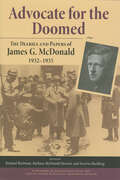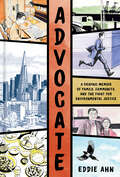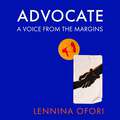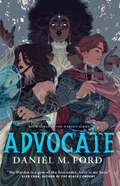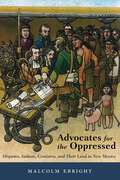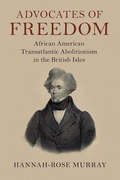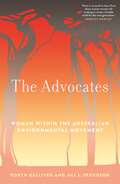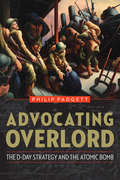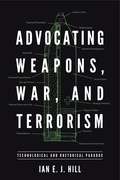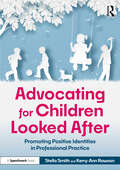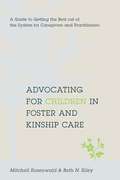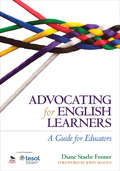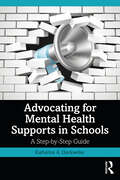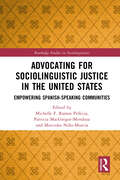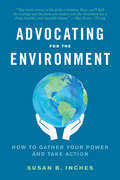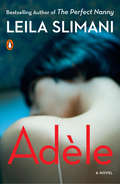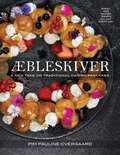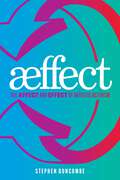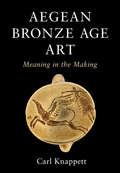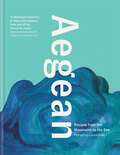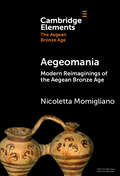- Table View
- List View
Advocate for the Doomed: The Diaries and Papers of James G. McDonald, 1932–1935
by James G. McDonald“[Chronicles] the efforts of this principled and persistent man to save Jews and others from the horrors of Nazism.” —Foreign AffairsThe private diary of James G. McDonald (1886–1964) offers a unique and hitherto unknown source on the early history of the Nazi regime and the Roosevelt administration’s reactions to Nazi persecution of German Jews. Considered for the post of US ambassador to Germany at the start of FDR’s presidency, McDonald traveled to Germany in 1932 and met with Hitler soon after the Nazis came to power. Fearing Nazi intentions to remove or destroy Jews in Germany, in 1933 he became League of Nations High Commissioner for Refugees and sought aid from the international community to resettle outside the Reich Jews and others persecuted there. In late 1935 he resigned in protest at the lack of support for his work.This is the eagerly awaited first of a projected three-volume work that will significantly revise the ways that scholars and the world view the antecedents of the Holocaust, the Shoah itself, and its aftermath.“A compelling look at one man’s efforts to do something about a looming catastrophe. At times the book is inspiring—McDonald’s prescience and energy are simply amazing. But because we know what is soon to happen to Europe’s Jews, we share his frustration that no one seems to be listening. We feel what it was to be an advocate for the doomed.” —The Wall Street Journal“The diaries show that McDonald believed as early as 1933 that the Nazis were considering the mass killing of Europe’s Jews.” —The New York Times
Advocate: A Graphic Memoir of Family, Community, and the Fight for Environmental Justice
by Eddie AhnA moving graphic memoir following Eddie Ahn, an environmental justice lawyer and activist striving to serve diverse communities in San Francisco amidst environmental catastrophes, an accelerating tide of racial and economic inequality, burnout, and his family&’s expectations.Born in Texas to Korean immigrants, Eddie grew up working at his family&’s store with the weighty expectations that their sacrifices would be paid off when he achieved the &“American Dream.&” Years later after moving to San Francisco and earning a coveted law degree, he then does the unthinkable: he rejects a lucrative legal career to enter the nonprofit world.In carving his own path, Eddie defies his family&’s notions of economic success, igniting a struggle between family expectations, professional goals, and dreams of community. As an environmental justice attorney, he confronts the most immediate issues the country is facing today, from the devastating effects of Californian wildfires to economic inequality, all while combatting burnout and racial prejudice. In coming fully into his own, Eddie also reaches a hand back to his parents, showing them the value of a life of service rather than one spent only seeking monetary wealth.Weaving together humorous anecdotes with moments of victory and hope, this powerful, deeply contemplative full-color graphic novel explores the relationship between immigration and activism, opportunity and obligation, and familial duty and community service.
Advocate: A voice from the margins
by Lennina OforiLennina Ofori is a force of nature. A teen mother, a supportive older sister, a PhD student, a support system, a working woman, a survivor, above all, she is an Advocate. She has spent her life working for those who do not have a voice, for those relegated to the margins, and in this book, she lends her voice to them.Starting with her own life story, from her beautiful family, to her hardest struggles, Ofori opens the door to intersections that are familiar to many: race, class and gender, and uses her expertise to explain and embolden readers to make active change in their own lives. Utilising expertise from across the globe, from the teachings of bell hooks to government reports, Ofori makes accessible topics that are so often ignored. From her unique perspective as a Black woman who has lived many lives, Ofori is a daring voice for change, and a voice for hope, in modern life.Advocate is a tale of personal resistance, but also a manifesto for action. With great candour, wit and beautiful language, Ofori will call you to make change not just for your own sake, but for those in the margins.
Advocate: A voice from the margins
by Lennina OforiPart-memoir, part-manifesto, Advocate demonstrates how we can all be a voice for change in an increasingly divided worldLennina Ofori is a force of nature. A teen mother, a supportive older sister, a PhD student, a support system, a working woman, a survivor, above all, she is an Advocate. She has spent her life working for those who do not have a voice, for those relegated to the margins, and in this audiobook, she lends her voice to them.Starting with her own life story, from her beautiful family, to her hardest struggles, Ofori opens the door to intersections that are familiar to many: race, class and gender, and uses her expertise to explain and embolden listeners to make active change in their own lives. Utilising expertise from across the globe, from the teachings of bell hooks to government reports, Ofori makes accessible topics that are so often ignored. From her unique perspective as a Black woman who has lived many lives, Ofori is a daring voice for change, and a voice for hope, in modern life.Advocate is a tale of personal resistance, but also a manifesto for action. With great candour, wit and beautiful language, Ofori will call you to make change not just for your own sake, but for those in the margins.(P)2023 Little Brown Book Group Limited for and on behalf of Dialogue Books
Advocate: A voice from the margins
by Lennina Ofori'Vital and illuminating . . . Advocate is a book that is equally generous and insightful, putting much of modern British narratives into sharp perspective . . . It's a gift' Jeffrey Boakye, author of Black, Listed and I Heard What You SaidLennina Ofori is a force of nature: a teen mother, a supportive older sister, a PhD candidate, a support system, a social entrepreneur, a survivor. Above all, she is an advocate. She has spent her life working for those relegated to the margins, and in this book, she lends her voice to them.Weaving in her own life story, from her beautiful family to her hardest struggles, Ofori opens the door to intersections that are familiar to many - race, class and gender - and uses her expertise to embolden readers to make active change in their own lives. Drawing on knowledge from across the globe, from the teachings of bell hooks to government reports, Ofori makes accessible topics that are so often ignored. From her unique perspective as a Black woman who has lived many lives, Ofori is a daring voice for change and hope in modern life.Advocate is a tale of personal resistance, but also a manifesto for action. With great candour, wit and beautiful language, Ofori will call you to make change not just for your own sake, but for those in the margins
Advocate: Book Three of The Warden Series (The Warden Series)
by Daniel M. Ford"Omigosh! I've just found an author to put on my list of I've got to read everything they ever wrote! The Warden is a gem of the first order. Aelis is my hero."—Glen Cook, author of The Black Company"These books are addictive and I can’t wait to see what Aelis and the gang get up to next.”—C.L. Clark, author of The UnbrokenWineshops on every corner. Assassins in every alley. It’s good to be home.Aelis de Lenti is back on her home turf, but it's not quite as welcoming as she remembered....Recalled from Lone Pine to investigate claims of murder by magic against her mentor—legendary Warden Bardun Jacques—Aelis takes to the streets of the grand city of Lascenise, and plumbs the deepest secrets of the Lyceum to clear his name. Certain of her success, she doesn't count on thieves, subterranean labyrinths, or the assassins that dog her steps from the moment she leaves her tower.Behind all of it lurks a ring of unknown wizards who can seemingly reach anyone with their magic. Without knowing who she can trust, Aelis must gather what allies she can to unravel the web of intrigue, murder, smuggling, and theft originating in the halls of magic power. With an old friend from her college days, a war-haunted gnome thief-catcher, and the advice of her imprisoned advisor, Aelis races to save lives and expose a conspiracy that seeks to change the face of the world.At the Publisher's request, this title is being sold without Digital Rights Management Software (DRM) applied.
Advocates for the Oppressed: Hispanos, Indians, Genízaros, and Their Land in New Mexico
by Malcolm EbrightStruggles over land and water have determined much of New Mexico&’s long history. The outcome of such disputes, especially in colonial times, often depended on which party had a strong advocate to argue a case before a local tribunal or on appeal. This book is partly about the advocates who represented the parties to these disputes, but it is most of all about the Hispanos, Indians, and Genízaros (Hispanicized nomadic Indians) themselves and the land they lived on and fought for.Having written about Hispano land grants and Pueblo Indian grants separately, Malcolm Ebright now brings these narratives together for the first time, reconnecting them and resurrecting lost histories. He emphasizes the success that advocates for Indians, Genízaros, and Hispanos have had in achieving justice for marginalized people through the return of lost lands and by reestablishing the right to use those lands for traditional purposes.
Advocates of Freedom: African American Transatlantic Abolitionism in the British Isles (Slaveries since Emancipation)
by Hannah-Rose MurrayDuring the nineteenth century and especially after the Civil War, scores of black abolitionists like Frederick Douglass, Moses Roper and Ellen Craft travelled to England, Ireland, Scotland, and parts of rural Wales to educate the public on slavery. By sharing their oratorical, visual, and literary testimony to transatlantic audiences, African American activists galvanised the antislavery movement, which had severe consequences for former slaveholders, pro-slavery defenders, white racists, and ignorant publics. Their journeys highlighted not only their death-defying escapes from bondage but also their desire to speak out against slavery and white supremacy on foreign soil. Hannah-Rose Murray explores the radical transatlantic journeys formerly enslaved individuals made to the British Isles, and what light they shed on our understanding of the abolitionist movement. She uncovers the reasons why activists visited certain locations, how they adapted to the local political and social climate, and what impact their activism had on British society.
Advocates: Women within the Australian Environmental Movement
by Robyn Gulliver Jill L FergusonFrom boardrooms to blockade camps, from the lush East Gippsland forests to the golden Ningaloo Reef, the fight against environmental destruction takes place in many spaces. The Advocates tells the inside story of nine extraordinary women within the Australian environmental movement and the behind-the-scenes efforts that have helped power advocacy across Australia. Over the past fifty years these advocates have held corporations to account, cleaned up toxic waste in their own backyards, and returned biodiversity to our forests. They are not always on the frontlines of the fight or the front pages of the news, but their relentless commitment to making change is both moving and inspiring. In often unseen and unacknowledged ways these women have educated, agitated and pioneered new approaches to the many crises in the Australian environment. Told through richly detailed interviews, these stories get to the heart of why these women have dedicated their lives to environmental causes and the different ways they have persevered. The Advocates shines a light on nine women's tireless commitment to change, and what it means to be an Australian environmental advocate. These stories will inspire the next generation to find a place in that vital fight.
Advocating Overlord: The D-Day Strategy and the Atomic Bomb
by Philip Padgett“Well there it is. It won’t work, but you must bloody well make it,” said the chief of Britain’s military leaders, when he gave orders to begin planning for what became known as Operation Overlord. While many view D-Day as one of the most successful operations of World War II, most aren’t aware of the intensive year of planning and political tension between the Allies that preceded the amphibious military landing on June 6, 1944. This intriguing history reveals how President Franklin D. Roosevelt, while on a fishing trip in the middle of World War II, altered his attitude toward Winston Churchill and became an advocate for Operation Overlord. Philip Padgett challenges the known narrative of this watershed moment in history and illuminates the diplomatic link between Normandy and the atomic bomb. He shows how the Allies came to agree on a liberation strategy that began with D-Day—and the difficult forging of British and American scientific cooperation that produced the atomic bomb. At its core this story is about how a new generation of leaders found the courage to step beyond national biases in a truly allied endeavor to carry out one of history’s most successful military operations.
Advocating Transitional Justice in Africa: The Role of Civil Society (Springer Series in Transitional Justice)
by Jasmina Brankovic Hugo van der MerweThis volume documents and analyses the strategies used by African civil society organisations to lobby for and enact transitional justice measures in their countries. The book offers local practitioners and African scholars space to reflect on the development and effectiveness of strategies in promoting transitional justice, as well as to identify the theoretical and contextual influences on transitional justice work. Most importantly, it presents lessons and best practices for advocating transitional justice. This edited volume fills a significant gap by providing an up-to-date regional African perspective on transitional justice in the form of a compilation of country-specific and thematic analyses of agenda-setting and lobbying efforts. It also offers insights into the state-civil society relationship on the continent. While including some historical perspective, the book chapters provide fresh and up-to-date insights into ongoing transitional justice efforts that are key to defining the future of how the field is understood in theory and in practice.
Advocating Weapons, War, and Terrorism: Technological and Rhetorical Paradox (RSA Series in Transdisciplinary Rhetoric #9)
by Ian E. HillTechnē’s Paradox—a frequent theme in science fiction—is the commonplace belief that technology has both the potential to annihilate humanity and to preserve it. Advocating Weapons, War, and Terrorism looks at how this paradox applies to some of the most dangerous of technologies: population bombs, dynamite bombs, chemical weapons, nuclear weapons, and improvised explosive devices.Hill’s study analyzes the rhetoric used to promote such weapons in the nineteenth and twentieth centuries. By examining Thomas R. Malthus’s Essay on the Principle of Population, the courtroom address of accused Haymarket bomber August Spies, the army textbook Chemical Warfare by Major General Amos A. Fries and Clarence J. West, the life and letters of Manhattan Project physicist Leo Szilard, and the writings of Ted “Unabomber” Kaczynski, Hill shows how contemporary societies are equipped with abundant rhetorical means to describe and debate the extreme capacities of weapons to both destroy and protect. The book takes a middle-way approach between language and materialism that combines traditional rhetorical criticism of texts with analyses of the persuasive force of weapons themselves, as objects, irrespective of human intervention. Advocating Weapons, War, and Terrorism is the first study of its kind, revealing how the combination of weapons and rhetoric facilitated the magnitude of killing in the nineteenth and twentieth centuries, and illuminating how humanity understands and acts upon its propensity for violence. This book will be invaluable for scholars of rhetoric, scholars of science and technology, and the study of warfare.
Advocating for Children Looked After: Promoting Positive Identities in Professional Practice
by Stella Smith Kerry-Ann RawsonThis accessible guide provides a detailed and practical understanding of how to support Children Looked After (CLA), exploring concepts surrounding identity and the key role professionals can play by becoming advocates for these children. With a mixture of theory, reflection and application to practice, Advocating for Children Looked After considers contemporary topics, from adverse childhood experiences (ACEs), labelling and stigma, to the relationships surrounding Children Looked After.Embedded within the chapters are positive everyday practices, case studies and dialogues, all of which help to create a safe space for children to develop their own sense of self. Throughout the book, outdated views are challenged and replaced with the voices of children and young people themselves, and strategies and opportunities are provided for the reader to truly understand the perspectives of Children Looked After and to develop their practice to best support their needs and well-being. Care is taken to refer to Children Looked After, rather than Looked After Children, placing the child at the forefront and before their care status.Informative and reflective, this book offers both students and professionals a diverse insight into what makes a Child Looked After unique, with the aim of breaking the cycle in regard to their development and outcomes. It will be key reading for all professionals including those within education and social work, as well as those on undergraduate, postgraduate, and professional childhood courses.
Advocating for Children in Foster and Kinship Care: A Guide to Getting the Best out of the System for Caregivers and Practitioners
by Mitchell Rosenwald Beth RileyThis book is the first to provide strategies for effective advocacy and placement within the foster care and kinship care systems. It also takes a rare look at the dynamics of the foster and kinship relationship, not just among children and the agency workers and service providers who intervene on their behalf, but also between children and those who take in and care for them as permanency develops. Drawing on their experience interacting with and writing about the institution of foster care, Mitchell Rosenwald and Beth N. Riley have composed a unique text that helps practitioners, foster parents, and relative caregivers realize successful transitions for youth, especially considering the traumas these children may suffer both before and after placement.Advocating for a child's best interests must begin early and remain consistent throughout assignment and adjustment. For practitioners, Rosenwald and Riley emphasize the best techniques for assessing a family's capabilities and for guiding families through the challenges of foster care. Part one details the steps potential foster parents and kinship caregivers must take, with the assistance of practitioners, to prepare themselves for placement. Part two describes tactics for successful advocacy within the court system, social service agencies, schools, and the medical and mental health establishments. Part three describes how to lobby for change at the agency and legislative levels, as well as within a given community. The authors illustrate recommendations through real-life scenarios and devote an entire chapter to brokering positive partnerships among practitioners, families, and other teams working to protect and transition children.
Advocating for English Learners: A Guide for Educators
by Diane Staehr FennerEmbrace the future by ensuring English Learners have a voice in school. English Learners (ELs) are the fastest-growing segment of the K–12 population. Therefore, educators must provide a voice for their needs. This book demystifies the techniques of advocacy for ELs, including: A shared sense of responsibility for EL success–Providing tools that every educator can use to ensure that ELs are effectively served An overview for administrators–Influencing policy and fostering a culture that meets EL needs Advocacy for ELs’ success beyond Grade 12–Equipping ELs for life after graduation, from higher education to career decisions
Advocating for Mental Health Supports in Schools: A Step-by-Step Guide
by Katherine A. DockweilerAdvocating for Mental Health Supports in Schools shows readers how to advocate for, and achieve, more mental health supports in schools. This timely book takes an actionable stance on the mental health issues schools are facing today, offering concrete strategies on how to advocate and what to advocate for. It contains model policy examples and expert advice from policy makers and practitioners across the country who are leaders in advocacy work. The book is divided into three sections. "Advocacy Truths" orients the reader as to what advocacy is and how to do it. "Policy Making" breaks down the complexity of the policy making process using simple terms and language, making it feel accessible and feasible. Finally, "Levels in Action" provides examples of federal, state, and local policy options to increase school-based mental health supports in schools. This section also outlines the ARTERY Pipeline Framework, showing readers how to systemically create workforce solutions to successfully recruit, train, and retain more school-based mental health professionals. Within this guide, educators; school-based mental health professionals; graduate students in school psychology, counseling, and social work; school board members; policy makers; families and others will find concrete solutions to incorporate into their advocacy work at all levels of policy making.
Advocating for Sociolinguistic Justice in the United States: Empowering Spanish-speaking Communities (Routledge Studies in Sociolinguistics)
by Mercedes Niño-Murcia Pellicia, Michelle F. Ramos Patricia MacGregor-MendozaThis collection focuses on social awareness and critical language awareness with the goal of enlightening and empowering multilingual and multicultural communities across the U.S.Each chapter brings to light the trauma, gaps in services and misguided societal perceptions that adversely impact communities whose linguistic and cultural background and/or status as migrants place them in vulnerable situations. In doing so, the authors and editors demonstrate how an increased awareness of diverse communities’ linguistic and cultural wealth can be leveraged to build strength and resilience in order to overcome physical, verbal or symbolic violence and provide remedies for inequities in educational, medical, and legal contexts.Showcasing discussions of the intersectionality and contexts in which language, power, migration, and the cultural funds of knowledge of minoritized communities interact, this volume will be of interest to students, scholars, and educators in sociolinguistics, applied linguistics, and language education.
Advocating for the Environment: How to Gather Your Power and Take Action
by Susan InchesAn accessible, solutions-oriented guide for addressing the earth's environmental crisis and enacting meaningful changeWhat can we as ordinary citizens do about climate change?" While countless environmental books focus on the causes of our current crisis, Advocating for the Environment is one of the first to focus on advocacy and policy-based solutions, arming readers with the tools they need to take action and enact change. In Part I, environmental policy expert Susan Inches discusses storytelling, empathy, mindset, and how effective communication can help us collaborate with others, even those with opposing views. Part II focuses on practical skills like coalition building, media relations, communication strategy, and navigating political and bureaucratic obstacles that block large-scale legislation. The book also includes case studies, research, and templates to deepen learning. Professors and teachers, students, legislators, environmental clubs, and church groups will also find useful ideas and strategies on every page.
Adèle: A Novel
by Leila SlimaniFrom the bestselling author of The Perfect Nanny--one of the 10 Best Books of the Year of The New York Times Book Review--her prizewinning novel about a sex-addicted woman in ParisShe wants only one thing: to be wanted. <P><P>Adèle appears to have the perfect life: She is a successful journalist in Paris who lives in a beautiful apartment with her surgeon husband and their young son. But underneath the surface, she is bored--and consumed by an insatiable need for sex. <P><P>Driven less by pleasure than compulsion, Adèle organizes her day around her extramarital affairs, arriving late to work and lying to her husband about where she's been, until she becomes ensnared in a trap of her own making. <P><P>Suspenseful, erotic, and electrically charged, Adèle is a captivating exploration of addiction, sexuality, and one woman's quest to feel alive.
Aebleskiver: A New Take on Traditional Danish Pancakes
by Pim Pauline OvergaardÆbleskiver presents 70 delicious twists on the classic Danish pancake, offering everything from sweet delights to savory bites. These versatile treats are ideal for any meal, especially a brunch gathering with family and friends."Even if you have never eaten æbleskiver, these little round Danish pancakes may be your new favorite food, thanks to Pim Pauline Overgaard&’s tempting, gorgeous cookbook. [...] Æbelskiver is a creative, playful, and lively cookbook that expands the possibilities of working with the cute pancake-esque pastries." —Foreword Reviews "With an enticing collection of recipes and beautiful photography throughout, Æbleskiver will inspire both novice cooks and seasoned chefs alike to explore the rich tapestry of Danish flavors through Denmark&’s favorite treat." —Pastry Arts magazine Discover the world of æbleskiver, the beloved sphere-shaped Danish pancakes traditionally savored during the holidays and for special celebrations. In this contemporary twist, more than 70 recipes transform these sweet delights to everyday fare. Home cooks will love the variety of dishes, including: • Savory spins on the Danish delicacy, ranging from Ricotta Salata Æbleskiver with Grilled Corn and Fresh Herb Spread to Saffron Rice Æbleskiver a la Paella. • Special desserts for any sweet tooth, including Almond Æbleskiverwith Warm Mixed Berry Compote and White Chocolate Hazelnut Æbleskiver with Sweet Beet Ice Cream and Candied Beet Chips. • Mouth-watering sub-recipes for sauces, jams, glazes, and other accompaniments that can take a humble æbleskiver to the heights of sophistication. These 70 recipes deliver fresh flavor combinations in addition to gluten-free and vegan variations for many of the recipes. And the vivid photography by the author will have you savoring the beauty and versatility of æbleskiver.
Aednan: An Epic
by Linnea AxelssonThe winner of Sweden&’s most prestigious literary award makes her American debut with an epic, multigenerational novel-in-verse about two Sámi families and their quest to stay together across a century of migration, violence, and colonial trauma.In Northern Sámi, the word Ædnan means the land, the earth, and my mother. These are all crucial forces within the lives of the Indigenous families that animate this groundbreaking book: an astonishing verse novel that chronicles a hundred years of change: a book that will one day stand alongside Halldór Laxness&’s Independent People and Sigrid Undset&’s Kristin Lavransdatter as an essential Scandinavian epic.The tale begins in the 1910s, as Ristin and her family migrate their herd of reindeer to summer grounds. Along the way, forced to separate due to the newly formed border between Sweden and Norway, Ristin loses one of her sons in the aftermath of an accident, a grief that will ripple across the rest of the book. In the wake of this tragedy, Ristin struggles to manage what&’s left of her family and her community.In the 1970s, Lise, as part of a new generation of Sámi grappling with questions of identity and inheritance, reflects on her traumatic childhood, when she was forced to leave her parents and was placed in a Nomad School to be stripped of the language of her ancestors. Finally, in the 2010s we meet Lise&’s daughter, Sandra, an embodiment of Indigenous resilience, an activist fighting for reparations in a highly publicized land rights trial, in a time when the Sámi language is all but lost.Weaving together the voices of half a dozen characters, from elders to young people unsure of their heritage, Axelsson has created a moving family saga around the consequences of colonial settlement. Ædnan is a powerful reminder of how durable language can be, even when it is borrowed, especially when it has to hold what no longer remains. &“I was the weight / in the stone you brought / back from the coast // to place on / my grave,&” one character says to another from beyond the grave. &“And I flew above / the boat calling / to you all: // There will be rain / there will be rain.&”
Aeffect: The Affect and Effect of Artistic Activism
by Stephen DuncombeThe first book to seriously identify how artistic activism works and how to make it work betterThe past decade has seen an explosion in the hybrid practice of “artistic activism,” as artists have turned toward activism to make their work more socially impactful and activists have adopted techniques and perspectives from the arts to make their interventions more creative. Yet questions haunt the practice: Does artistic activism work aesthetically? Does it work politically? And what does “working” even mean when one combines art and activism? In Æffect, author Stephen Duncombe sets out to address these questions at the heart of the field of artistic activism.Written by the co-founder and current Research Director of the internationally recognized Center for Artistic Activism, Æffect draws on Duncombe’s more than twenty-five years of experience in the field and one hundred in-depth interviews with artistic activists worldwide. More than a mere academic exercise, the theory, research, and tools in this book lay the groundwork for artistic activists to evaluate and strengthen their practice and to create better projects. The exploration of good artistic activism is grounded in three sets of concerns. 1) Change: Upon what theories of change is artistic activism based? 2) Intention: What do we hope and expect artistic activism to do, and how does it do this? 3) Evaluation: What actually happens as the result of an artistic activist intervention? Can it be measured?Æffect is rich with examples that demonstrate successful artistic activism, including Undocubus, an old bus painted “No Fear” across its side that was driven cross-country by a group of undocumented immigrant activists; Journal Rappé, a video show created by Senegalese rappers who created long-form investigative reports by rapping the current news in French and Wolof; and War on Smog, a staged a public performance piece by artistic activists in the city of Chongqing in Southwest China. Scannable QR codes are included to provide tools that help readers assess the æffect of their artistic activism.
Aegean Bronze Age Art: Meaning in the Making
by Carl KnappettHow do we interpret ancient art created before written texts? Scholars usually put ancient art into conversation with ancient texts in order to interpret its meaning. But for earlier periods without texts, such as in the Bronze Age Aegean, this method is redundant. Using cutting-edge theory from art history, archaeology, and anthropology, Carl Knappett offers a new approach to this problem by identifying distinct actions - such as modelling, combining, and imprinting - whereby meaning is scaffolded through the materials themselves. By showing how these actions work in the context of specific bodies of material, Knappett brings to life the fascinating art of Minoan Crete and surrounding areas in novel ways. With a special focus on how creativity manifests itself in these processes, he makes an argument for not just how creativity emerges through specific material engagements but also why creativity might be especially valued at particular moments.
Aegean: Recipes from the Mountains to the Sea
by Marianna Leivaditaki'A delicious evocation of place and memory from one of my favourite cooks.' Allan Jenkins, Editor of Observer Food Monthly'This book is so much more than a cookbook, it's a love song to a very special place and we are lucky to have the brilliant Marianna as our guide.' Itamar Srulovich, co-founder of Honey & Co.'I want to make everything in this beautiful book. An absolute treasure.' Rosie Birkett, author of The Joyful Home CookWith photography from Elena Heatherwick, the Fortnum & Mason Food and Drink Photographer of the Year 2020Marianna Leivaditaki is a natural storyteller. She grew up in Chania, on the Greek island of Crete, and spent her childhood helping out in the family-run taverna. After school, she carried around her blue notebook, writing downall the recipes she would like to cook, helped by the Greek grannies' kitchen wisdom. Marianna's love for the food of her heritage flows off every page, but she also has a contemporary take on it. As head chef of Morito in Hackney, she has championed high-quality ingredients, presenting them in simple, stunning sharing plates, and has been critically acclaimed for doing so.These inspirational recipes derive from the SEA, the LAND and the MOUNTAINS. We all know the health benefits of a Mediterranean diet, rich in olive oil, fresh vegetables and fruit, nuts, fish and whole grains, as well as the importanceof how you eat and appreciate your food. Marianna offers achievable, yet delicious dishes celebrating seasonal, fresh food that you can take time to enjoy with friends and family.
Aegeomania: Modern Reimaginings of the Aegean Bronze Age (Elements in The Aegean Bronze Age)
by Nicoletta MomiglianoThis Element provides an overview of Aegeomania: the fascination, sometimes bordering on the obsession, with the Aegean Bronze Age, which manifests itself in the uses of Aegean Bronze Age material culture to create something new in literature, the visual and performing arts, and many other cultural practices. It discusses the role that Aegeomania can play in our understanding of the Aegean Bronze Age and illustrates this with examples from the 1870s to the present, which include, among many others, poems by Emma Lazarus, Salvatore Quasimodo, and Giorgos Seferis; novels by Kristmann Gudmundsson, Mary Renault, Don DeLillo, Zeruya Shalev, and Sally Rooney; Freudian psychoanalysis; sculptures by Henry Moore and Pablo Picasso; music by Harrison Birtwistle and the rock band Giant Squid; films by Robert Wise and Wolfang Petersen; elegant textiles and garments created by Josef Frank and Karl Lagerfeld. This title is also available as Open Access on Cambridge Core.
